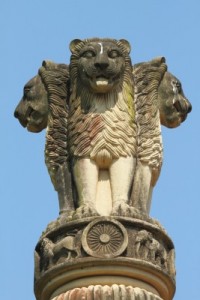By Pamela Toler (Regular Contributor)
Emperors tend to be known for their military conquests: Alexander the Great, Julius Caesar, Genghis Khan, Napoleon. The emperor Ashoka, who ruled the Maurya empire of India from 269 to 232BCE, is best known for his conversion to Buddhism and subsequent rejection of military aggression .
In the early years of his reign, Ashoka was a successful warrior who expanded the borders of his empire to include most of modern Afghanistan, Bangladesh, India and Pakistan–an area larger than any other Indian ruler would command.
In 261, Ashoka led a brutal expedition against the neighboring kingdom of Kalinga (modern Orissa). Sickened by the loss of life, he converted to Buddhism and proclaimed his conversion to his subjects in a series of inscriptions engraved on rocks and pillars throughout his kingdom, the 3rd century BCE equivalent of billboards. In what are now known as the “Ashokan edicts”*, which appear to have been written by the emperor himself, he outlined his new dedication to “moral conquest” in place of military campaigns and rules for running a Buddhist kingdom.
In pursuit of his Buddhist ideals, Ashoka banned the animal sacrifices that were an important part of the Vedic religion, reduced the consumption of meat in the palace, and replaced the royal pastime of hunting with pilgrimages to Buddhist holy places. Despite his support of the Buddhist principle of ahimsa (non-violence) at a personal level, Ashoka never wholly embraced pacifism; he guaranteed the peace of his enormous empire with an army that included 600,000 foot soldiers, thirty thousand cavalry and nine thousand war elephants.
When modern India gained its independence in 1947, the new state chose the cluster of four lions that serve as the capital on the Ashokan pillar at Sarnath as its emblem. The choice was intended as a statement of India’s commitment to religious tolerance within a secular state.
*You can read a translation of the edicts here.
Image credit: mkistryn / 123RF Stock Photo
This post first appeared at Wonders & Marvels on 18 July 2013.

